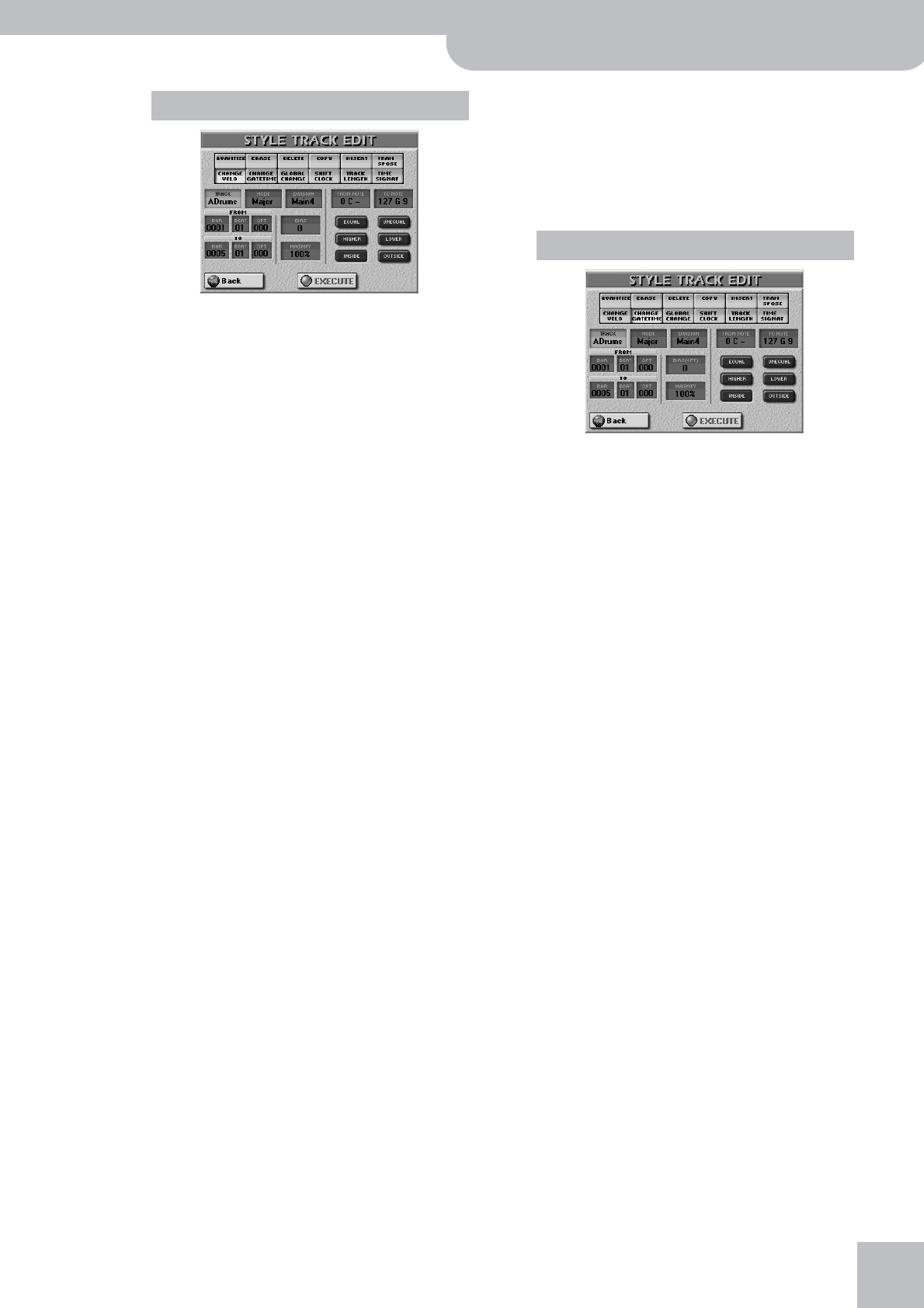
Style Track Edit functions
G-70 Music Workstation
r
195
The CHANGE VELO function allows you to modify the
dynamics (called velocity) of a track or excerpt. See
p. 167 for details. Only note events can be changed.
■TRACK (ADrums~Acc6, ALL)
Allows you to select the track you want to edit. Select “ALL”
to edit all tracks.
■MODE
Allows you to select the mode of the pattern to be edited:
“Major”, “minor” or “7th”.
■DIVISION
Use this parameter to select the Division (or pattern) you
want to edit: Intro 1~4, Main 1~4, Fill Dwn 1~3, Fill Up 1~
3, End 1~4.
■FROM/TO
FROM refers to the position where the edit operation is to
begin. That position is specified as Bar-Beat-CPT values. TO
designates the position where the edit operation is to end
(Bar-Beat-CPT value). See page 191 for details.
■BIAS (–99~99)
The BIAS parameter allows you to specify by how much the
velocity values should change. Select a positive value to
increase the velocity (the value is added to the velocity
value of the affected notes), or a negative value to
decrease the velocity values (that value is subtracted).
Select “0” if you prefer to work with the MAGNIFY parame-
ter (see below).
Note: Even the highest positive or negative VALUE doesn’t
allow you to go beyond “1” or “127”. There is a reason why “0”
is impossible: that value is used to indicate the end of a note
(note-off). “127”, on the other hand, is the highest velocity
value the MIDI standard can muster. Selecting a high positive
velocity value may thus lead to all notes being played at “127”.
■MAGNIFY (0~200%)
This parameter works like a “compander” effect (a dynamics
processor that simultaneously acts as compressor and
expander), although it processes MIDI data: by selecting a
value above “100%” you increase the differences between
high and low velocity values in the selected range. Values
below “64” are lowered, while values above “64” are
increased. The result is therefore that the difference
between pianissimo and fortissimo becomes far more pro-
nounced.
MAGNIFY values below “100%” have the opposite effect:
they push all velocity towards the imaginary center of “64”,
thus reducing differences in playing dynamics.
■FROM NOTE/TO NOTE (0 C-~127 G9)
FROM NOTE refers to the lower limit of the note range you
want to change. TO NOTE represents the upper limit. See
also “Fine-tuning the note range” on p. 192.
■EXECUTE
Press this field to confirm your settings and edit the data.
The CHANGE GATE TIME function allows you to mod-
ify the duration of the notes in the selected time
(FROM/TO) and note (FROM/TO NOTE) ranges. See
page 168 for details.
■TRACK (ADrums~Acc6, ALL)
Allows you to select the track you want to edit. Select “ALL”
to edit all tracks.
■MODE
Allows you to select the mode of the pattern to be edited:
“Major”, “minor” or “7th”.
■DIVISION
Use this parameter to select the Division (or pattern) you
want to edit: Intro 1~4, Main 1~4, Fill Dwn 1~3, Fill Up 1~
3, End 1~4.
■BIAS (CPT) (–1920~1920)
This parameter sets the amount by which the dura-
tion (or gate time) of the selected notes is to change.
The shortest possible GATE TIME value is “1” (used for
all drum notes), so that selecting “–1000” for notes
with a GATE TIME value of “1” in the specified time
range still leaves you with the same value. You can-
not use CHANGE GATE TIME to erase notes.
■MAGNIFY (0~200%)
Use this parameter rather than BIAS to produce propor-
tional changes to the affected GATE TIME values. Values
below “100%” decrease the duration, while anything above
“100%” increases it. Select “100%” if you prefer to work
with the BIAS (CPT) parameter (see above).
■FROM NOTE/TO NOTE (0 C-~127 G9)
FROM NOTE refers to the lower limit of the note range you
want to change. TO NOTE represents the upper limit. See
also “Fine-tuning the note range” on p. 192.
■EXECUTE
Press this field to confirm your settings and edit the data.
CHANGE VELO
CHANGE GATE TIME


















